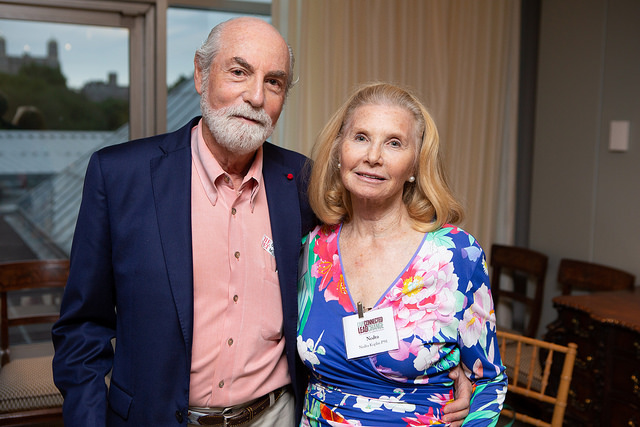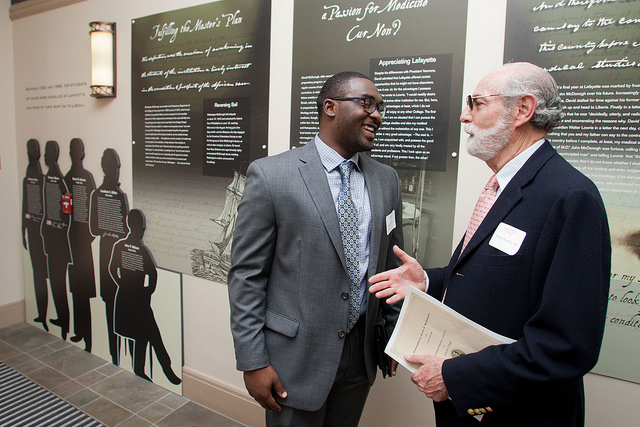Paging Dr. McDonogh
By Bill Landauer
In the 1890s, a hospital opened in New York, the first in the U.S. not to discriminate against people of color. It was named McDonough Memorial after David McDonogh 1844.
Despite this honor, until recently much about McDonogh has remained lost to obscurity. The story of Lafayette’s first African American graduate and America’s first black eye doctor, a unique saga of how he established himself as an outstanding student at the newly minted College on the Hill in Easton, is only now slowly emerging from the shadows.
Today, clubs and societies inspired by the story of a Lafayette alumnus who found freedom from slavery to become a physician are forming around the name McDonogh.
But as passionate as McDonogh scholars are about the man, they’ve never seen a photograph of his face. Nor do they understand everything about what he accomplished in his lifetime. Faculty, students, alumni, and staff have set out to add flesh to the figure of McDonogh. They’re pouring through old newspapers, letters, and books to discover anything they can that’s been swept away over the years.
The more they learn, the longer McDonogh’s shadow seems to grow.
“I can’t believe we’re still finding things,” says Diane Shaw, director of special collections and College archives, who, along with New York physician Richard Koplin ’64, has headed up most of the work delving into McDonogh’s past.
 In the early 2000s, Koplin was a member of a group of alumni forming an organization to help support graduates seeking a medical education. The group wanted to name their organization for an auspicious alum. Shaw told them about the McDonoghs—David and Washington.
In the early 2000s, Koplin was a member of a group of alumni forming an organization to help support graduates seeking a medical education. The group wanted to name their organization for an auspicious alum. Shaw told them about the McDonoghs—David and Washington.
In the years following Lafayette’s founding, a slave owner named John McDonogh from New Orleans, member of the American Colonization Society, sought to educate and free some of his slaves with the understanding that they’d move from the U.S. to Liberia and work in mission schools.
McDonogh sent David and Washington (they chose to use the McDonogh surname and called John McDonogh father) to Lafayette. Washington’s tenure at Lafayette was attenuated, and he dutifully emigrated to Liberia in 1842. As graduation loomed, David informed John McDonogh that he would not leave for Liberia as originally agreed. John’s response was to cut David off, leaving him without support. Nonetheless, David graduated, and through introductions made by his Lafayette guardian, Walter Lowrie, he attended medical school in New York City and became a bona fide physician.
The story had largely vanished from the local consciousness until the 1980s. An article appeared in the alumni magazine. It was the nidus of an awareness long overdue. A unique individual had graduated from Lafayette whose story begged to be told. As David McDonogh’s name began to ring across the campus, active research began in earnest. Just who was David McDonogh?
Curlee Holton, Roth Professor Emeritus of Art and then head of the Experimental Printmaking Institute, became fascinated by the story. He helped the College engage and commission sculptor Melvin Edwards in 2008 to craft Transcendence, the massive sculpture dedicated to McDonogh outside Skillman Library.
Though many of the details remain buried, the McDonogh story’s power continues to grow.
“I think both stories are just fascinating, and really instructive of two different strains,” Shaw says. “The one that really died out, the idea of colonization, and the one that succeeded, the one that said blacks should be free in America. And now! Not gradual emancipation, but immediate emancipation.”
The David McDonogh story, in particular, resonated with Koplin, in part because David was an attending physician at New York Eye and Ear Infirmary, where Koplin is a director.
“It’s something to aspire to,” he says of the McDonogh story. “So I became Diane’s wingman.”
He hired professional researchers. He scoured the internet. Meanwhile at Lafayette, EXCEL Scholars and classes taught by Wendy Wilson-Fall, associate professor and chair of Africana studies, began to peruse letters among the McDonogh family, Washington McDonogh in Liberia, Lowrie, and Lafayette officials. A substantial library has grown and is kept in Lafayette’s special collections, as well as the Presbyterian Historical Society of Philadelphia. There also is a special collection of John McDonogh’s history in the Tulane Library. Interestingly, they knew nothing of David.
As the view of the man became more focused, the McDonogh story grew legs. In New York, a researcher employed by Koplin and Lafayette located McDonogh’s great-great-granddaughter Patricia Worthy. “I hoped she would have a box under the bed with photographs and everything related to her illustrious family member,” Koplin says. But the woman knew little more than that her ancestor had been a doctor.
After graduating from Lafayette, David McDonogh attended medical school at Columbia University. Though he completed his coursework, the school refused to confer a degree because of McDonogh’s race. Koplin and Shaw approached Columbia and related their extensive research and suggested it was time to confer a posthumous degree for David. In May of this year, at Columbia’s commencement exercises, David’s great-great-granddaughter was presented with his degree.
Working with Koplin, a writer is developing a screenplay for a six-part miniseries based on David McDonogh’s life.
 Koplin “never let this story die,” Shaw says. “He’s very passionate about it.”
Koplin “never let this story die,” Shaw says. “He’s very passionate about it.”
“In telling David’s story, Diane represents the most crafted academic version,” Koplin says, “while I do the Hollywood version … We’ve been very successful in blowing this story up from something rather skeletal.”
The full scope of McDonogh’s achievements still remains elusive.
McDonogh was active in the abolitionist movement, Koplin and Shaw have discovered. Digging through early Harlemite newspapers, the two researchers discovered a trove of new material, and David’s name appears prominently among the Frederick Douglass newspapers in the 1860s. He apparently travelled New York state extensively in support of the abolitionist and workers’ rights movements. So far there’s nothing to prove the two ever stood in the same room together, Koplin says, but there’s reason to believe the two men working toward the same aims might well have been acquainted.
But how influential was McDonogh to the movement? Koplin hopes to find more. He’s found little about McDonogh’s work as a doctor. Who were his patients? What was his bedside manner like?
Among Koplin’s findings is a photograph of a large crowd of people and New York dignitaries gathered in the 1910s for the dedication of another hospital—one that was never completed—in New York, also to be named for the famous Lafayette alumnus.
“What did David McDonogh do for the public good as a physician and as a participant in the abolitionist movement that found him in such high regard that a hospital was established in his name?” Koplin says. “Clearly there is more to this story.”